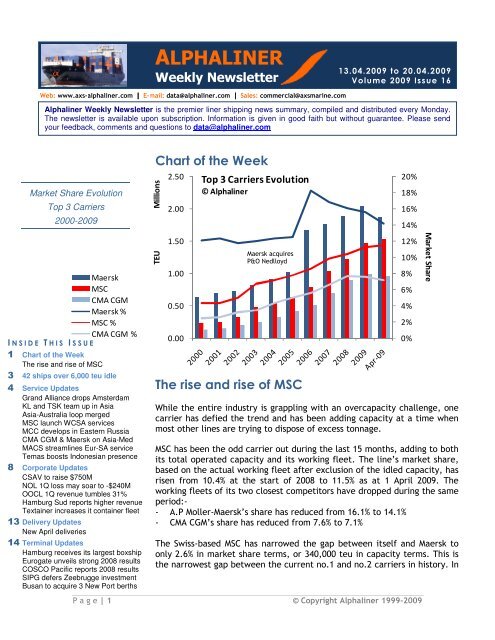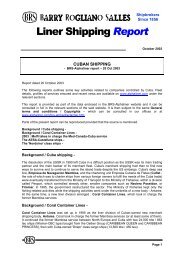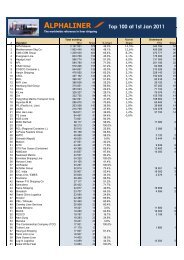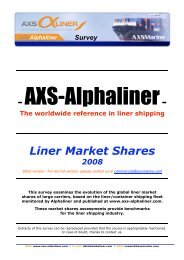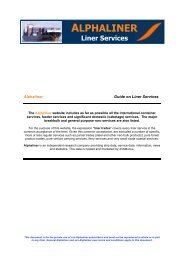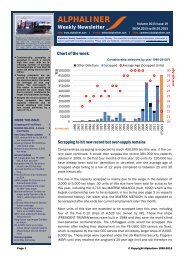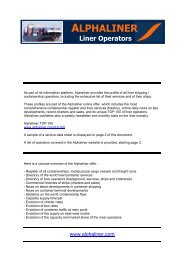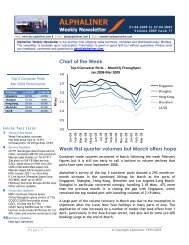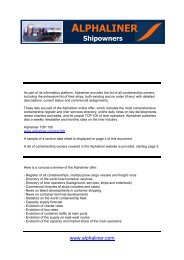AXS-Alphaliner Newsl..
AXS-Alphaliner Newsl..
AXS-Alphaliner Newsl..
You also want an ePaper? Increase the reach of your titles
YUMPU automatically turns print PDFs into web optimized ePapers that Google loves.
ALPHALINER<br />
Weekly <strong>Newsl</strong>etter<br />
Web: www.axs-alphaliner.com | E-mail: data@alphaliner.com | Sales: commercial@axsmarine.com<br />
13.04.2009 to 20.04.2009<br />
Volume 2009 Issue 16<br />
<strong>Alphaliner</strong> Weekly <strong>Newsl</strong>etter is the premier liner shipping news summary, compiled and distributed every Monday.<br />
The newsletter is available upon subscription. Information is given in good faith but without guarantee. Please send<br />
your feedback, comments and questions to data@alphaliner.com<br />
Market Share Evolution<br />
Top 3 Carriers<br />
2000-2009<br />
Maersk<br />
MSC<br />
CMA CGM<br />
Maersk %<br />
MSC %<br />
CMA CGM %<br />
I N S I D E T H I S I S S U E<br />
1 Chart of the Week<br />
The rise and rise of MSC<br />
3 42 ships over 6,000 teu idle<br />
4 Service Updates<br />
Grand Alliance drops Amsterdam<br />
KL and TSK team up in Asia<br />
Asia-Australia loop merged<br />
MSC launch WCSA services<br />
MCC develops in Eastern Russia<br />
CMA CGM & Maersk on Asia-Med<br />
MACS streamlines Eur-SA service<br />
Temas boosts Indonesian presence<br />
8 Corporate Updates<br />
CSAV to raise $750M<br />
NOL 1Q loss may soar to -$240M<br />
OOCL 1Q revenue tumbles 31%<br />
Hamburg Sud reports higher revenue<br />
Textainer increases it container fleet<br />
13 Delivery Updates<br />
New April deliveries<br />
14 Terminal Updates<br />
Hamburg receives its largest boxship<br />
Eurogate unveils strong 2008 results<br />
COSCO Pacific reports 2008 results<br />
SIPG defers Zeebrugge investment<br />
Busan to acquire 3 New Port berths<br />
TEU Millions<br />
Chart of the Week<br />
2.50<br />
2.00<br />
1.50<br />
1.00<br />
0.50<br />
0.00<br />
Top 3 Carriers Evolution<br />
© <strong>Alphaliner</strong><br />
Maersk acquires<br />
P&O Nedlloyd<br />
The rise and rise of MSC<br />
P a g e | 1 © Copyright <strong>Alphaliner</strong> 1999-2009<br />
20%<br />
18%<br />
16%<br />
14%<br />
12%<br />
10%<br />
While the entire industry is grappling with an overcapacity challenge, one<br />
carrier has defied the trend and has been adding capacity at a time when<br />
most other lines are trying to dispose of excess tonnage.<br />
MSC has been the odd carrier out during the last 15 months, adding to both<br />
its total operated capacity and its working fleet. The line’s market share,<br />
based on the actual working fleet after exclusion of the idled capacity, has<br />
risen from 10.4% at the start of 2008 to 11.5% as at 1 April 2009. The<br />
working fleets of its two closest competitors have dropped during the same<br />
period:-<br />
- A.P Moller-Maersk’s share has reduced from 16.1% to 14.1%<br />
- CMA CGM’s share has reduced from 7.6% to 7.1%<br />
The Swiss-based MSC has narrowed the gap between itself and Maersk to<br />
only 2.6% in market share terms, or 340,000 teu in capacity terms. This is<br />
the narrowest gap between the current no.1 and no.2 carriers in history. In<br />
8%<br />
6%<br />
4%<br />
2%<br />
0%<br />
Market Share
ALPHALINER Weekly <strong>Newsl</strong>etter 2009-Week 16<br />
axs-alphaliner.com – the worldwide reference in liner shipping<br />
Top 3 Carriers<br />
Volume Growth<br />
MSC operating costs<br />
lower than its<br />
competitors?<br />
Carrier CAGR 2005-2008<br />
Maersk 1.9%<br />
MSC 17.3%<br />
CMA CGM 23.8%<br />
MSC Newbuilding<br />
Delivery Schedule<br />
2009-2011<br />
Delivery TEU Shipyard<br />
Feb-09 11,660 Hyundai<br />
Mar-09 13,798 Samsung<br />
Mar-09 14,000 Daewoo<br />
May-09 14,000 Daewoo<br />
May-09 13,798 Samsung<br />
May-09 4,254 Zhejiang<br />
Jun-09 13,798 Samsung<br />
Jun-09 4,254 Zhejiang<br />
Jul-09 4,254 Zhejiang<br />
Aug-09 13,798 Samsung<br />
Oct-09 13,798 Samsung<br />
Dec-09 13,798 Samsung<br />
Jan-10 14,000 Daewoo<br />
Jan-10 13,798 Samsung<br />
Feb-10 14,000 Daewoo<br />
Mar-10 14,000 Daewoo<br />
May-10 14,000 Daewoo<br />
Jul-10 14,000 Daewoo<br />
Nov-10 14,000 Daewoo<br />
Feb-11 14,000 Daewoo<br />
TEU Millions<br />
14.00<br />
12.00<br />
10.00<br />
8.00<br />
6.00<br />
4.00<br />
2.00<br />
0.00<br />
Top 3 Carriers - Liftings 2005-2008<br />
2008 TEU 2007 TEU 2006 TEU 2005 TEU<br />
Maersk Line<br />
2008, MSC liftings increased by 5% to reach 10.5 Mteu, closing in on<br />
Maersk’s 13.8 Mteu.<br />
Most other carriers are actively laying up idle capacity. Notably, carriers<br />
such as APL have 21 ships of 3,300-6,400 teu idled, representing 22% of its<br />
operated capacity at today’s count. In the case of these lines the cost of<br />
keeping ships inactive is apparently lower than operating them on<br />
unprofitable routes at the moment.<br />
MSC on the other hand has only 2 ships currently believed in idle status.<br />
The line has in fact been adding capacity by chartering ships at bargain<br />
rates. While most carriers ceased to charter ships and to the contrary<br />
redeliver excess tonnage, MSC is on its side breathing life into the charter<br />
market for large ships. During the past six months, it has chartered a dozen<br />
ships of the 2,500-6,000 teu range for periods of 12 to 24 months, plus ten<br />
other ships for shorter periods. Recent fixtures include the 24-monthscharter<br />
of ER FRANCE (5,762 teu) at a reported $8,000/day, SANTA CELINA<br />
(3,430 teu) at $7,250/day for 12 months and CALA PANCALDO and CALA<br />
PIGAFETTA (2,785 teu) at $6,000/day for 12 months.<br />
MSC’s fleet has also been boosted by the addition of three ULCS of 14,000<br />
teu (MSC DANIELA and DANIT classes) and four VLCS of 11,660 teu (MSC<br />
SOLA class), all assigned to its Far East-Europe 'Silk' service. The carrier<br />
seems unaffected by the downturn and is for the moment receiving its<br />
large newbuildings on schedule. MSC’s orderbook includes a further 41<br />
units over 12,500 teu.<br />
Below this size, the carrier’s orderbook is surprisingly low, with six units of<br />
5,550 teu and three ones of 4,250 teu. This explains why MSC has been<br />
active in chartering ships of this size during the past 12 months, including a<br />
series of five 5,500-5,700 teu ships taken en bloc from Hyundai M.M. last<br />
summer for delivery in January-April 2009.<br />
In the meantime, MSC has been active in the scrap market, sending two<br />
dozen (15 owned, 9 chartered) of its aging ships to the breakers, removing<br />
43,000 teu from its fleet since September. All of these ships have been<br />
P a g e | 2 © Copyright <strong>Alphaliner</strong> 1999-2009<br />
MSC<br />
CMA CGM
Note :<br />
ALPHALINER Weekly <strong>Newsl</strong>etter 2009-Week 16<br />
axs-alphaliner.com – the worldwide reference in liner shipping<br />
To avoid any misinterpretation, <strong>Alphaliner</strong><br />
uses the word ‘IDLE’ instead of ‘LAID UP’.<br />
Idle ships include:<br />
- Carrier-controlled ships left without<br />
service assignment<br />
- Chartered ships redelivered to owners<br />
with no further employment<br />
- Ships in long term lay-up<br />
- Ships damaged or under long time repairs<br />
following damage (or under conversion)<br />
- Ships arrested for financial/legal reasons<br />
Following categories are NOT included as<br />
idle:<br />
- Ships awaiting their sailing slot as they<br />
change service (if waiting period is less<br />
than a week)<br />
- Ships in routine GR/dry-dock<br />
- Ships waiting to a berth at the roads /<br />
anchorages due to strike, missed slot or<br />
port congestion<br />
Idle ships by operators<br />
> 6,000 teu<br />
Operator No of Idle ships<br />
Maersk Line 14<br />
APL 8<br />
CSAV 5<br />
CSCL 3<br />
OOCL 2<br />
MISC Bhd 2<br />
IRISL 2*<br />
MOL 1<br />
MSC 1<br />
Evergreen 1<br />
HMM 1<br />
COSCO 1<br />
UASC 1<br />
* Note: IRISL ships are lying at yard<br />
and have not been handed over<br />
to owner<br />
more than 28 years old, including the 40 years old MSC STEFANIA and six<br />
other ships built in 1970. MSC still has 42 ships (22 owned and 20<br />
chartered) built before 1980 currently in its fleet, totalling 64,000 teu.<br />
42 ships of over 6,000 teu idle<br />
1. Tracking idle container ships is a challenge as most owners and operators<br />
do not disclose the ships they put at anchor. <strong>Alphaliner</strong> has implemented<br />
procedures that allow the identification of idle vessels with a high degree<br />
of reliability. Other methods such as those relying only on tracking inactive<br />
ships using AIS (Automatic Identification System) data or other automated<br />
reporting are prone to error.<br />
2. Furthermore, these automated methods of tracking idle ships suffer from<br />
several disadvantages, notably the inability to track ships that are outside<br />
of the coverage range. Such methods also incorrectly treat empty ships<br />
which are moving from one anchorage to another as ‘active’ while actually<br />
they are not actively working and thus continue to be considered ‘idle’ by<br />
<strong>Alphaliner</strong>. Conversely, certain ships in routine dry-dock are erroneously<br />
considered as idle while they should not be, as dry-docking is a routine<br />
part of ship operations.<br />
3. The AIS-based or other automated analysis are also based on a certain<br />
number of inactive days before declaring ships as inactive, thereby missing<br />
out early data as it takes between 7 to 21 days before these inactive ships<br />
are actually classified as idle. Observation also shows that these methods<br />
have erroneously classified as idle some ships routed via the Cape of Good<br />
Hope, as AIS often fails to capture ships in such remote waters.<br />
<strong>Alphaliner</strong>’s tracking method provides a more comprehensive and up-todate<br />
snapshot of the idle fleet with a satisfying degree of reliability. Ships<br />
are classified as inactive as soon as they leave an active assignment. This<br />
data is updated on a daily basis, thereby providing a reliable and up-todate<br />
account of the current inactive fleet.<br />
As at 20 April, a total of 42 ships of more than 6,000 teu capacity tracked<br />
by <strong>Alphaliner</strong> are now classed as idle. Maersk Line currently has the largest<br />
number of large ships idle with 14 such ships followed by APL which has 8<br />
ships of above 6,000 teu that are inactive.<br />
Detailed idle containership statistics are available exclusively from<br />
<strong>Alphaliner</strong>. They include vessel and operator particulars. The report<br />
provides a unique insight into the current operating environment for both<br />
owners and operators. For subscription details, please contact us at<br />
commercial@axsmarine.com<br />
P a g e | 3 © Copyright <strong>Alphaliner</strong> 1999-2009
ALPHALINER Weekly <strong>Newsl</strong>etter 2009-Week 16<br />
axs-alphaliner.com – the worldwide reference in liner shipping<br />
SERVICE UPDATES<br />
Amsterdam left with sole<br />
mainline service<br />
following departure of<br />
EU 2<br />
Current crisis prompts<br />
further service<br />
consolidation in<br />
Intra-Asia<br />
Grand Alliance drops Amsterdam on EU 2<br />
The Grand Alliance (Hapag-Lloyd + NYK + OOCL + MISC Bhd) is to alter the<br />
European range rotation of its Asia-Europe Loop 2 (EU 2) service.<br />
The main change concerns the inclusion of Rotterdam at the expense of<br />
Amsterdam. The EU2 used to call at the Ceres Terminal in Amsterdam,<br />
which used to be controlled by alliance member NYK. Since December<br />
2008, the terminal has been under the control of Hutchison Port Holdings<br />
(HPH) which obtained a majority stake in a share-swap agreement with<br />
NYK. Under the terms of the agreement, NYK was granted by HPH a<br />
minority stake in Rotterdam’s Europe Container Terminals (ECT).<br />
With the EU 2 dropping Amsterdam, the Ceres Terminal is now left with<br />
only a single deep sea loop calling, the Grand Alliance’s Asia-Europe Loop<br />
1 (EU 1).<br />
On its side, Rotterdam is reported to consider a reduction in port dues in<br />
order to attract additional traffic. The port of Rotterdam had earlier<br />
reported a 16% decline in container volumes to 2.3M TEU for the first<br />
quarter of 2009. The port forecasts a decline in throughput of 6%-10% for<br />
2009. It says problems in container shipping continue to dominate the<br />
situaltion and that recovery will begin “a little later than anticipated”.<br />
K Line and TSK team up on intra Asia services<br />
K Line and TSK (Tokyo Senpaku Kaisha - the intra-Asia arm of NYK) have<br />
reached an agreement to launch a joint service between Japan, the<br />
Philippines and the Straits / Jakarta sector from mid-May 2009.<br />
In response to the ongoing financial crisis that has drastically reduced<br />
cargo volume for this sector, the two carriers will merge two existing,<br />
independent services, the TSK's 'Pegasus' service (PGS) and the K Line's<br />
'Pineapple Express' into one service, unifying fleet deployment to their<br />
maximum size, thereby improving efficiency and schedule integrity.<br />
Four vessels of about 1,700 teu will be deployed on a 28-day round voyage<br />
to provide a weekly service (two provided by K Line and two by TSK). It<br />
will cover Osaka, Shimizu, Tokyo, Yokohama, Nagoya, Kobe, Keelung,<br />
Manila, Singapore, Port Kelang, Jakarta, Singapore, Manila, Osaka.<br />
In addition to this newly-established joint service, both carriers also agree<br />
to widen their cooperation by exchanging slots with each other on their<br />
existing services, to maximize efficiency and provide a wider range of<br />
services to their customers.<br />
P a g e | 4 © Copyright <strong>Alphaliner</strong> 1999-2009
ALPHALINER Weekly <strong>Newsl</strong>etter 2009-Week 16<br />
axs-alphaliner.com – the worldwide reference in liner shipping<br />
Consolidation also in<br />
Asia-Australian trades<br />
2 new services in WCSA<br />
launched<br />
upgraded Western and<br />
Central Med coverage<br />
Asia-Australia loops merged temporarily<br />
Two Asia-Australia loops connecting Japan and China to Melbourne, Sydney<br />
and Brisbane are to be temporarily merged into a single loop. The services<br />
concerned are the ANL / CSCL / OOCL North Asia-China-Australia (NACA)<br />
loop and the NYK / MOL / K Line Asia-SE Australia (AUS 2) service.<br />
The two services are merged into a temporary joint service, run with six<br />
ships of around 4,000 teu (instead of a total of ten ships for the two<br />
original loops). A seventh carrier, COSCO, is also involved through a slot<br />
allocation on the NYK-MOL-K Line loop.<br />
ANL, market leader on this run, explains that the decision is motivated by<br />
''the continued downward trend of world trade in the current economic<br />
conditions caused by the financial crisis and the continued depressed<br />
freight rate levels''. The original pattern is to be re-instated when the<br />
market recovers.<br />
MSC launches American Pacific coast services<br />
MSC has announced the introduction of two new services linking the US<br />
West Coast, Mexico and Central America to the West Coast of South<br />
America.<br />
The 'Puma' service will link ports in USA, Mexico, Guatemala, El Salvador,<br />
Costa Rica and Panama, offering a weekly service between Balboa, Long<br />
Beach, Oakland, Manzanillo, and Puerto Caldera. In addition, fortnightly<br />
calls will also be offered at Salina Cruz, Mazatlan, Puerto Quetzal and<br />
Acajutla. The first sailing will occur from Balboa on 29 April with the MSC<br />
PERU to be followed by two other ships of between 1,600-2,100 teu.<br />
The 'Condor' service will link ports in Peru, Ecuador, Colombia and Panama<br />
by offering a weekly service between Balboa, Callao, Paita, Guayaquil, and<br />
Buenaventura. Three ships of about 1,200 teu will be deployed with the<br />
first sailing to start from Balboa on 17 April with the MSC PAOLA.<br />
The two new services will hub at Balboa, located at the Pacific side of the<br />
Panama Canal - this port has not been used by MSC so far.<br />
CMA CGM and Maersk team up on Asia-Med<br />
CMA CGM today announced the following improvements on its Asia-<br />
Mediterranean services, starting from mid-May :<br />
CMA CGM will offer an upgraded coverage of Western and Central<br />
Mediterranean from Asia, including direct calls at Lianyungang and<br />
Qingdao, within a new Vessel Sharing Agreement with Maersk on a service<br />
based on the current Maersk's AE-11 loop. It will rotate as follows :<br />
Lianyungang, Qingdao, Shanghai, Fuzhou, Hong Kong, Chiwan, Yantian,<br />
P a g e | 5 © Copyright <strong>Alphaliner</strong> 1999-2009
ALPHALINER Weekly <strong>Newsl</strong>etter 2009-Week 16<br />
axs-alphaliner.com – the worldwide reference in liner shipping<br />
Tanjung Pelepas, Jeddah, Port Said, Gioia Tauro, Genoa, Fos, Gioia Tauro,<br />
Damietta, Port Said, Salalah, Port Kelang, Singapore, Lianyungang. The<br />
service will be operated with nine vessels of about 8,500 teu, eight of<br />
which provided by Maersk and one by CMA CGM (The newbuilding CMA CGM<br />
CENDRILLON).<br />
CMA CGM will revamp its Asia-Adriatic PHEX/LEVEX within a new<br />
partnership with Maersk Line through a Vessel Sharing Agreement, with<br />
each company providing four vessels of 6,500 teu. The new service ''will<br />
offer faster transit times to Trieste, Koper and Rijeka''. It will rotate as<br />
follows : Shanghai, Busan, Hong Kong, Chiwan, Tanjung Pelepas, Port<br />
Kelang, Port Said, Damietta, Trieste, Koper, Rijeka (by feeder), Damietta,<br />
Port Said, Jeddah, Port Kelang, Singapore, Shanghai<br />
MCC develops own Eastern Russia feeder<br />
MCC Transport, the APM-Maersk intra Asia arm, has launched its own<br />
Busan-Eastern Russia feeder services, covering Vladivostok and Vostochny,<br />
using the chartered 698 teu OSG BEAUTEC and OSG BOSSTEC (the latter<br />
sub-chartered from Chinese carrier Onto Shipping).<br />
On this run, MCC Transport / Maersk used to either buy slots or to deploy<br />
ships on an ad hoc basis from time to time. The two new services connect<br />
at Busan with long haul services of Maersk and MCC. Maersk-MCC is also<br />
offering direct Shanghai-Russia services through slot buying on the FESCO.<br />
In December 2004, APM-Maersk had acquired SCF Oriental Lines from<br />
Sovcomflot Logistics, a carrier which offered Korea-Russia services using<br />
the Vostochny gateway for oncarriage of boxes on the Trans-Siberian<br />
Railway.<br />
As for Onto Shipping, it is to replace the OSG BOSSTEC by the 672 teu JIN<br />
MAN YANG on its Lianyungang-Qingdao-Japan service.<br />
MACS streamline Europe – S Africa service<br />
MACS Maritime Carrier has removed two ships from its Europe-South Africa<br />
multipurpose and breakbulk service. The two ships are the 26,000 tdw/850<br />
teu conbulkers STELLENBOSCH and ALGOA BAY. The service is now run with<br />
five multipurpose units, two of which are fitted with ramps.<br />
STELLENBOSCH and ALGOA BAY, both 31 years old, are actually sent on the<br />
Southern Africa-Mexico-USA 'Gulf Africa Line' (GAL - a joint service of MACS<br />
and Dannebrog) on which they replace two 38-year-old conbulkers of<br />
30,000 tdw / 1,100 teu, earmarked for scrap: the BLUE MASTER and<br />
SILVERFJORD.<br />
These two pairs of ships are veterans of the South Africa trade, carrying<br />
containers and machinery as well as granite blocks exported from South<br />
Africa. MACS is awaiting a series of 37,000 tdw / 2,000 teu newbuildings<br />
P a g e | 6 © Copyright <strong>Alphaliner</strong> 1999-2009
ALPHALINER Weekly <strong>Newsl</strong>etter 2009-Week 16<br />
axs-alphaliner.com – the worldwide reference in liner shipping<br />
ordered in China. The first of them is planned for delivery at the end of the<br />
year.<br />
Temas boosts Indonesian presence<br />
Indonesian carrier PT Pelayaran Tempuran Emas (Temas Line) is enhancing<br />
its fleet with both newbuildings from China and second hand purchases. It<br />
has recently received the 537 teu ESTUARI MAS from the Ningbo Boda<br />
Shipyard and two 296 teu units, the LAGUN MAS and GUHI MAS, from the<br />
Yuenshan Shipyard. It has also purchased two second hand ships : the 1,002<br />
teu KAWA MAS (built 1985 - ex X-PRESS MANASLU purchased from<br />
Singapore-based owners linked to Sea Consortium) and the brand new 538<br />
teu LAGOA MAS, purchased from a Chinese owner which took her in charge<br />
only a few weeks ago.<br />
Last year, Temas also added the SUNGAI MAS (500 teu - built 1980 - ex<br />
X-PRESS PUMORI). With these newcomers, Temas Line operates today a<br />
fleet of 32 ships representing 15,760 teu, all owned, deployed on three<br />
sets of routes out of Jakarta and out of Surabaya, covering a dozen of<br />
Indonesian ports.<br />
P a g e | 7 © Copyright <strong>Alphaliner</strong> 1999-2009
ALPHALINER Weekly <strong>Newsl</strong>etter 2009-Week 16<br />
axs-alphaliner.com – the worldwide reference in liner shipping<br />
CORPORATE UPDATES<br />
CSAV Top 10<br />
Shareholders as at end<br />
Dec 2008<br />
Shareholder Name % Share<br />
MARITIMA DE INVERSIONES<br />
(CLARO FAMILY)<br />
45.59%<br />
BANCHILE BROKERS 3.34%<br />
PHILTRA LIMITADA 3.15%<br />
AFP CUPRUM PENSION FUND 2.86%<br />
CHILE ELECTRONIC STOCK EXC 2.79%<br />
AFP HABITAT PENSION FUND 2.70%<br />
LARRAIN VIAL BROKERS 2.47%<br />
AFP CAPITAL PENSION FUND 2.34%<br />
BANCO DE CHILE FOR<br />
CHAP XIV 3 rd PARTIES<br />
1.96%<br />
HENDAYA CONSULTING 1.94%<br />
Total TOP 10 69.14%<br />
CSAV Newbuilding<br />
Delivery Schedule<br />
2009-2012<br />
Dely Teu Shipyard<br />
Aug-09 6,589 CSBC*<br />
Sep-09 6,589 CSBC<br />
Nov-09 6,589 CSBC*<br />
Jan-10 6,589 CSBC<br />
Mar-10 6,589 CSBC*<br />
May-10 6,589 CSBC<br />
Jul-10 12,552 Samsung*<br />
Oct-10 12,552 Samsung<br />
Jan-11 12,552 Samsung*<br />
Apr-11 12,552 Samsung<br />
Jun-11 12,552 Samsung*<br />
Oct-11 12,552 Samsung<br />
Jan-12 12,552 Samsung*<br />
Mar-12 12,552 Samsung<br />
_______________________________<br />
* LT Charter from Peter Dohle<br />
CSAV also have additional charter<br />
arrangements with Seaspan and<br />
Hermann Buss<br />
CSAV to raise $750M of new equity<br />
CSAV is planning to raise up to $750M of new equity as it faces a<br />
challenging year ahead that could see it lose up to $300M in 2009.<br />
The company plans to raise $350M from current shareholders, with a first<br />
exercise expected to raise $130M in rights issue scheduled to be completed<br />
in the first half of the year. The company now plans to raise a further<br />
$220M from its shareholders in a second rights issue.<br />
A further $400M could come from the capitalisation of outstanding charter<br />
party commitments on ships that CSAV currently have on charter, which<br />
will give the shipowners a direct equity stake in the company in lieu of<br />
charter payments.<br />
CSAV’s commitments on newbuildings include four 12,500 teu vessels at<br />
Samsung and three 6,500 teu vessels at CSBC with a total value of $890M.<br />
These ships were acquired from German owner Peter Dohle who has the<br />
largest exposure to CSAV. Dohle has 13 ships currently on long term charter<br />
to CSAV and a further 7 newbuildings scheduled for delivery between 2009<br />
and 2012 for Chilean carrier. Dohle is believed to be taking the lead<br />
amongst the group of owners in negotiating the capitalisation of charter<br />
contracts.<br />
One of the companies affected is Pacific Shipping Trust (PST) which has<br />
filed an update to the Singapore stock exchange that CSAV is seeking to<br />
reduce charter rates on two PST-owned 4,250 teu ships by 30% of which<br />
part of the reduction could be capitalised. Other owners that could be<br />
affected could include Seaspan and German owners, Hermann Buss, Laeisz<br />
Schiffahrt and NVA.<br />
In a press release, CSAV said that meetings were held in Hamburg during<br />
the second week of April with “shipowners, ship financing banks and<br />
shipyards and to address the tasks necessary for CSAV to counter the<br />
pressures the company is facing due to the very difficult economic<br />
environment.” The company reported that “the discussions went very<br />
positively and in a highly constructive way” and that the restructuring plan<br />
“has found positive reception and details of such a proposal are currently<br />
being worked out.”<br />
Besides the meetings with ship-owners, discussions are taking place with<br />
other stakeholders, including shipyards to negotiate the current new<br />
building program. CSAV is confident that as part of the overall<br />
restructuring process, agreements will be made with the shipyards as well<br />
in due time.<br />
P a g e | 8 © Copyright <strong>Alphaliner</strong> 1999-2009
250<br />
200<br />
150<br />
100<br />
50<br />
0<br />
-50<br />
-100<br />
-150<br />
-200<br />
-250<br />
-300<br />
ALPHALINER Weekly <strong>Newsl</strong>etter 2009-Week 16<br />
axs-alphaliner.com – the worldwide reference in liner shipping<br />
NOL Group<br />
Quarterly Profit/Loss<br />
1Q07 to 1Q09 (forecast)<br />
US$M<br />
1Q<br />
07<br />
2Q<br />
07<br />
3Q<br />
07<br />
4Q<br />
07<br />
1Q<br />
08<br />
2Q<br />
08<br />
3Q<br />
08<br />
APL Newbuilding<br />
Delivery Schedule<br />
2009-2012<br />
Dely Teu Shipyard<br />
2012 10,700 Daewoo<br />
2012 10,700 Daewoo<br />
2012 10,700 Daewoo<br />
2012 10,700 Daewoo<br />
2012 10,070 Hyundai<br />
2012 10,070 Hyundai<br />
2012 10,070 Hyundai<br />
2012 10,070 Hyundai<br />
APL also has 20 ships on LT<br />
charter arrangements due in<br />
2009-2012<br />
4Q<br />
08<br />
1Q<br />
09<br />
(F)<br />
NOL first quarter loss could soar to -$240M<br />
Neptune Orient Lines Limited, the parent company of APL, has issued a<br />
profit warning to the Singapore stock exchange, announcing that it<br />
anticipates its first quarter 2009 results to show an estimated net loss of<br />
US$240M, which is in excess of the net loss of US$149 million which the<br />
Group reported for 4Q 2008.<br />
The first quarter results for the Singapore based carrier will be reported on<br />
12 May 2009. In its release, NOL blamed the seasonally slower first quarter<br />
period for the slump in profits. However, the company added that “this<br />
deterioration in performance is also due to a worsening of business<br />
operating conditions in the first quarter. On the expectation of adverse<br />
business operating conditions continuing, NOL expects its full year loss to<br />
be significantly worse”.<br />
Following the announcement, some analysts have downgraded earnings<br />
estimates for NOL. BNP Paribas revised its full year net loss estimate to<br />
$486M, which is significantly more than the consensus estimate that<br />
currently stands at $230M.<br />
Earlier, NOL had announced plans for an additional $250M-$300M in cost<br />
savings, bringing the annual total for 2009 to $500M-$550M. The company<br />
says that the expected loss for the year is notwithstanding the ongoing cost<br />
savings and mitigation efforts undertaken by the company.<br />
NOL president and chief executive Ron Widdows has taken a “voluntary”<br />
20% reduction in remuneration from March, while the company’s chairman<br />
will be taking a 40% reduction in director’s pay. In November, the company<br />
had already announced a reduction of its global workforce by 1,000<br />
positions, mainly in North America. Further job losses and salary<br />
adjustments could still follow.<br />
NOL had earlier denied speculation that it is considering a rights issue to<br />
raise its capital base to cope with the difficult period. Given the latest<br />
announcement on the potentially significant losses expected this year, the<br />
company may still need to undertake measures to shore up its capital<br />
structure. The company has $467M of short term borrowings that is due to<br />
be repaid in 2009.<br />
Apart from its commitments on eight ships of 10,000 teu on order for<br />
delivery in 2012, the company has 20 additional ships on long term charter<br />
contracts due for delivery between 2009 and 2012. It has already<br />
negotiated with shipyards and owners for later delivery of its new vessels<br />
and currently has 21 ships (22% of its capacity) idle, making it one of the<br />
worst casualties of the current over-capacity environment.<br />
P a g e | 9 © Copyright <strong>Alphaliner</strong> 1999-2009
ALPHALINER Weekly <strong>Newsl</strong>etter 2009-Week 16<br />
axs-alphaliner.com – the worldwide reference in liner shipping<br />
OOCL revenue tumbles 31% in first quarter<br />
Hong Kong based OOCL has released its first quarter operational update<br />
with total revenues dropping by 31.2% to $954M from $1.4M a year ago.<br />
Liftings were 15.6% down from the same period last year.<br />
The overall load factor dropped by 11% compared with last year despite a<br />
1.2% decrease in capacity. Overall average revenue per teu decreased by<br />
18.5% compared with the same period last year.<br />
OOCL Operating Highlights 1Q 2009 breakdown by trade<br />
Liftings (teu) Revenue ($'000) $/teu<br />
Trade 1Q2009 1Q2008 Change 1Q2009 1Q2008 Change 1Q2009 1Q2008 Change<br />
Trans-Pacific 279,377 329,496 -15.2% 409,980 496,598 -17.4% 1467 1507.144 -2.6%<br />
Asia/Europe 164,300 191,904 -14.4% 149,819 343,521 -56.4% 9121.8624 1790.067 -49.1%<br />
Trans-Atlantic 85,378 99,713 -14.4% 131,153 168,955 -22.4% 1536.145 1694.413 -9.3%<br />
Intra-Asia/Australasia 449,107 538,036 -16.5% 263,215 378,232 -30.4% 586.0853 702.9864 -16.6%<br />
TOTAL 978,162 1,159,149 -15.6% 954,167 1,387,306 -31.2% 975.4693 1196.831 -18.5%<br />
All trades suffered<br />
reductions in both<br />
volume and rates<br />
The carrier saw the largest revenue slide on the Asia-Europe trades, with<br />
revenue more than halved from $344M to $150M. Liftings fell by 14% but<br />
more significantly, rates on the trade dropped by 49% which contributed to<br />
the drastic slide in profitability.<br />
Surprisingly, the intra-Asia and Australasian trades also took a severe<br />
hammering, with revenue falling by 30% to $263M. Both volumes and rates<br />
in the trade dropped by about 16.5%. This trade represents OOCL’s largest<br />
tradelane, accounting for 46% of its total liftings.<br />
All tradelanes suffered a drop in both rates and volumes. While the Trans-<br />
Pacific trade saw the lowest drop in revenue per teu, the impact of the<br />
rate slump will likely be felt from May onwards when the new Trans-Pacific<br />
contracts are in place.<br />
The carrier said it plans to slash capacity and admits that the outlook<br />
remains “poor” with rates falling below profitable levels. The first-quarter<br />
operating results were released a month after the parent company Orient<br />
Overseas (International) Ltd (OOIL) announced a drop in underlying net<br />
profit for 2008 which halved to $272.3M as a result of higher costs and a<br />
challenging environment for OOCL.<br />
Responding to the crash in volumes, the company plans to cut capacity by<br />
20% in 2009 by redelivering chartered-in tonnage and suspending services.<br />
OOCL currently has 14% of its capacity idled.<br />
P a g e | 10 © Copyright <strong>Alphaliner</strong> 1999-2009
Liftings in M teu<br />
% Increase<br />
ALPHALINER Weekly <strong>Newsl</strong>etter 2009-Week 16<br />
axs-alphaliner.com – the worldwide reference in liner shipping<br />
2.669<br />
Hamburg Sud<br />
Volume Growth<br />
2006-2008<br />
25%<br />
2.143<br />
16%<br />
1.840<br />
21%<br />
2008 2007 2006<br />
Hamburg Sud Newbuilding<br />
Delivery Schedule<br />
2009-2012<br />
Dely Teu Shipyard<br />
Mar-09 5,560 Daewoo (DMHI)<br />
May-09 5,905 Daewoo (DMHI)<br />
Aug-09 5,905 Daewoo (DMHI)<br />
Oct-09 7,100 Daewoo (DMHI)<br />
Dec-09 7,100 Daewoo (DMHI)<br />
Dec-09 5,905 Daewoo (DMHI)<br />
Feb-10 7,100 Daewoo (DMHI)<br />
Apr-10 7,100 Daewoo (DMHI)<br />
May-10 4,600 Daewoo (DSME)<br />
Jun-10 7,100 Daewoo (DMHI)<br />
Jul-10 4,600 Daewoo (DSME)<br />
Aug-10 7,100 Daewoo (DMHI)<br />
Hamburg Süd reports higher revenue & volume<br />
The Hamburg Süd Group presented what it called a “satisfactory result” for<br />
2008 but warns that 2009 will be a challenging year for the liner services.<br />
The carrier’s total turnover in 2008 rose by 32.8% to $6.5Bn of which liner<br />
revenue accounted for $5.5Bn or 84% of the total revenue. In addition to<br />
the liner operations, the group also operates 60 tramp ships on the bulk<br />
trades which includes the tramp operations of Rudolf A. Oetker and<br />
Furness Withy Chartering. The group, which is part of the German Oetker<br />
Group does not disclose actual profit figures.<br />
Hamburg Süd’s container volume grew by an impressive 25% to reach 2.67<br />
Mteu. Part of the increase was due to the acquisition of Costa Container<br />
Lines (CCL) which was taken over in November 2007. It eventually dropped<br />
the Costa brand name at the end of 2008 and currently only operates<br />
alongside its Brazillian sister company Alianca. Over the last decade, the<br />
company’s liftings have averaged an annual increase of 21%, due partly to<br />
the acquisitions that were made during that period which had included<br />
Ellerman Line, Kien Hung, Ybarra and the cross-trade operations of FESCO.<br />
The carrier had earlier said that “for the first time in many years, 2008 saw<br />
a structural overcapacity in container ships and this will continue to rise<br />
substantially in the months ahead. Even if world trade were to experience<br />
a recovery in 2010 - a situation not yet foreseeable today - it would still<br />
take quite some time for supply and demand in container shipping to<br />
achieve equilibrium.”<br />
The present downturn hit the Hamburg Süd liner operations in the final<br />
quarter of 2008 when vessel utilisation fell to 72%. The Line said that its<br />
core trades from Asia, Europe and North America to South America East<br />
Coast were worst hit and South American imports had collapsed by 40% and<br />
exports were down 20% in January.<br />
Like all major carriers, Hamburg Süd has embarked on a cost-saving<br />
program that will attempt to streamline its liner network and make cuts in<br />
its cost structure, with target savings of up to €300M in 2009. The cost<br />
cutting measures will reach from a freeze in hiring to re-negotiations of<br />
terminal charges and vessel charter rates. Hamburg Süd currently has<br />
about 8% of its capacity idle.<br />
The carrier also has a significant orderbook with a series of 12 ships due for<br />
delivery over 2009 to 2010. This includes six ships of 7,100 teu from a<br />
series of ten units initially ordered by CP Offen that will be deployed on its<br />
ECSA trades. They will be fitted with up to 1,500 reefer plugs, which will<br />
make them the world's largest reefer ships.<br />
P a g e | 11 © Copyright <strong>Alphaliner</strong> 1999-2009
ALPHALINER Weekly <strong>Newsl</strong>etter 2009-Week 16<br />
axs-alphaliner.com – the worldwide reference in liner shipping<br />
Textainer to acquire<br />
Amficon fleet from 1 May<br />
Main Container Leasing<br />
Companies<br />
Total Dry Container Fleet<br />
as at Jan 2009<br />
Textainer increases its container fleet<br />
Leading container lessor, Textainer announced on 16 April that it has<br />
acquired the management rights to 150,000 teu of containers from<br />
Amphibious Container Leasing Limited (Amficon). The acquisition takes<br />
effect from 1 May. Arising from this purchase, Textainer will operate a<br />
fleet of approximately 2.2 million TEU of mainly dry containers.<br />
With the acquisition, Textainer would control approximately 19% of the<br />
global leasing market for dry containers, further extending its current lead<br />
at the top of the leasing fleet table. The acquisition of Amficon’s<br />
significant number of flat rack and open top containers will also double<br />
Textainer’s fleet of specialized containers, a market segment that it is<br />
planning to strategically increase.<br />
This is the latest in a series of consolidations in the container leasing<br />
sector as it grapples with a challenging operating environment with<br />
difficult funding conditions and carrier returning surplus container units to<br />
lessors. Textainer has earlier acquired the management of the fleet of<br />
Gateway in 2006 and Capital Lease in 2007.<br />
Textainer<br />
Florens<br />
Triton<br />
TAL<br />
GE Seaco<br />
CAI<br />
Seacastle<br />
Gold<br />
UES/GVC<br />
Cronos<br />
Dong Fang<br />
Capital<br />
Amficon<br />
Beacon<br />
Top 15 Container Leasing Company Fleet as at Jan 2009<br />
(Dry containers only excl Reefers)<br />
CARU<br />
Textainer and Amficon<br />
fleet to be combined<br />
from 1 May 2009<br />
0.00 0.50 1.00 1.50 2.00 2.50<br />
TEU Millions<br />
P a g e | 12 © Copyright <strong>Alphaliner</strong> 1999-2009
ALPHALINER Weekly <strong>Newsl</strong>etter 2009-Week 16<br />
axs-alphaliner.com – the worldwide reference in liner shipping<br />
DELIVERY UPDATES<br />
Recent Deliveries<br />
April 2009<br />
Name Teu Operator<br />
BELUGA NATION 474 N/A<br />
CCL NINGBO 698 Centrans<br />
O.M. UNDARUM 704 N/A<br />
ALASKABORG 964 N/A<br />
MARE 974 Contaz<br />
VEGA AQUILA 997 N/A<br />
EMPIRE 1,440 N/A<br />
WARNOW MASTER 1,496 N/A<br />
MAERSK WINDHOEK 1,708 Maersk<br />
CSCL CALLAO 2,544 CSCL<br />
FESCO DIOMID 3,108 MSC<br />
ZIM DALIAN 4,253 Zim<br />
RUDOLF SCHEPERS 4,256 K Line<br />
COSCO FUKUYAMA 4,506 COSCO<br />
NYK REMUS 4,922 NYK<br />
APL WASHINGTON 6,966 APL<br />
XIN DA YANG ZHOU 8,530 CSCL<br />
HAMMERSMITH BR. 9,040 K Line<br />
CMA CGM HYDRA 10,960 CMA CGM<br />
XIN DA YANG ZHOU (8,530 teu) is delivered<br />
CSCL is to receive the 8,530 teu XIN DA YANG ZHOU, last of five sister<br />
ships ordered by CSCL at the Hudong-Zhonghua Shipbuilding (Group) Co<br />
Ltd (aka Hudong Shipyard) in October 2004. Her completion was delayed<br />
by the crash of a gantry crane at the yard last July. Her employment is<br />
currently unknown. The XIN DA YANG ZHOU follows the XIN FEI ZHOU,<br />
delivered in December.<br />
NYK REMUS (4,922 teu) is delivered<br />
NYK has received the NYK REMUS, ninth unit in a series of twelve 4,922<br />
teu panamaxes ordered at Hyundai H.I. in two steps in November 2004 and<br />
November 2006. The NYK REMUS was initially expected to join the Grand<br />
Alliance-Zim new FE-USEC joint service (SCE), but this plan was altered<br />
and the ship is believed to join at a later date. She follows the NYK<br />
DENEB, delivered one year earlier.<br />
RUDOLF SCHEPERS (4,256 teu) joins K Line<br />
German shipowner Rudolf Schepers has taken delivery of the 4,256 teu<br />
RUDOLF SCHEPERS, first unit in the ‘Jiangsu 4250’ series produced by the<br />
Jiangsu Yangzijiang shipyard.<br />
The RUDOLF SCHEPERS joins her charterer K Line, which has assigned her<br />
to the Far East-ECSA SEAS service run by CMA CGM, Maruba, CSCL and K<br />
Line. This service was organized in March 2009 through the merger of the<br />
SEAS 1 and SEAS 2 loops.<br />
COSCO FUKUYAMA (4,506 teu) is delivered<br />
COSCO Container Lines has taken in charge the COSCO FUKUYAMA, fourth<br />
of a series of 4,506 teu panamaxes ordered at Samsung by Japanese<br />
financing house Itochu Corp. with the backing of a COSCO long term<br />
charter. The COSCO FUKUYAMA is assigned to the CKYH FE-USEC 'AWE 2'<br />
loop. She follows the COSCO OSAKA, delivered in September<br />
CSCL CALLAO (2,544 teu) is delivered<br />
Seaspan Corporation has received the 2,544 teu CSCL CALLAO, seventh of<br />
eight ships of the 'Jiangsu 2500' design ordered by this owner to the<br />
Jiangsu Yangzijiang Shipbuilding Co.<br />
The CSCL CALLAO is chartered to CSCL for a period of 12 years. She will<br />
start her career on the Far East-Africa service offered by Hapag-Lloyd,<br />
CSCL and Maruba (WAX/WSX). She is the 20th unit built in the 'Jiangsu<br />
2500' series and follows the CSCL SAN JOSE, delivered in December.<br />
P a g e | 13 © Copyright <strong>Alphaliner</strong> 1999-2009
ALPHALINER Weekly <strong>Newsl</strong>etter 2009-Week 16<br />
axs-alphaliner.com – the worldwide reference in liner shipping<br />
TERMINAL UPDATES<br />
VLCS presents<br />
challenges to current<br />
Hamburg draft conditions<br />
Hamburg receives its largest containership<br />
The port of Hamburg has welcomed its largest-ever containership, the<br />
11,356 teu CMA CGM ANDROMEDA, completed two months ago by Hyundai<br />
H.I. and assigned to the French Line’s FAL-1 loop. The call came less than<br />
two weeks after Antwerp’s first ULCS call, which was performed by MSC<br />
BEATRICE (13,798 teu)<br />
The 363 m vessel is another milestone for Hamburg. Calls like those of CMA<br />
CGM ANDROMEDA and the recent visit of MARIT MAERSK (10,000 teu) on her<br />
delivery voyage, prove that Hamburg is ready to handle vessels of more<br />
than 360 metres in length as regular callers.<br />
Currently, most of the large mainline container ships at Hamburg stand in<br />
the 8,000 to 10,000 teu range. Typically, such vessels have a length of 335<br />
to 350 m, while the new breed of 11,300 to 14,000 teu ships will measure<br />
about 365 metres in length. The step from VLCS to ULCS might seem small,<br />
but Hamburg – just as Antwerp – is a river port, where vessels have to<br />
travel some four hours upriver from the open sea and negotiate a busy and<br />
winding fairway. In order to ensure that such river ports remain<br />
competitive in the long term is it essential that they can handle the coming<br />
generation of containerships.<br />
However, neither Antwerp nor Hamburg nor any comparable river port can<br />
presently accept very large and ultra-large vessels at full draft. In such<br />
ports, the ships have to sail in with the flood tide on a slightly reduced<br />
draft. These drawbacks are compensated by Hamburg’s and Antwerp’s<br />
proximity to the consumer markets, the final destination of the ships’<br />
cargo. In order to further improve nautical conditions for large (container)<br />
vessels, dredging schemes are in the pipeline for both Hamburg’s river Elbe<br />
and Antwerp’s river Scheldt.<br />
At Hamburg, the CMA CGM ANDROMEDA is handled at HHLA’s Burchardkai<br />
(CTB). CTB is presently undergoing a reconstruction scheme that will add<br />
multiple ULCS-ready berths and double the facility's capacity to 5.2 Mteu<br />
per year. The CMA CGM ANDROMEDA is presently the largest ship in CMA<br />
CGM’s fleet. She is the first of a series of 12 units. CMA CGM is due to<br />
receive its first of a series of eight 13,300 teu ship in July.<br />
P a g e | 14 © Copyright <strong>Alphaliner</strong> 1999-2009
ALPHALINER Weekly <strong>Newsl</strong>etter 2009-Week 16<br />
axs-alphaliner.com – the worldwide reference in liner shipping<br />
Cost management to<br />
cope with downturn<br />
Eurogate unveils strong 2008 results<br />
The Eurogate Group, a German stevedore and terminal operator created in<br />
1999 through the merger of Hamburg’s Eurokai and the Bremen-based BLG,<br />
has presented its figures for the year 2008. Despite the slow market,<br />
Eurogate closed fiscal 2008 with the best operating result in the company’s<br />
10-year history.<br />
Like for many terminal operators, 2008 was a peculiar year for Eurogate.<br />
An extraordinarily strong first half of 2008 boosted the company’s<br />
performance to such a degree that it has offset the low end year<br />
volumes.The group increased its revenue by 8.4% to €715M and posted a<br />
profit of €116.5M, 3.5% above the previous year’s level. It handled a total<br />
of 14.2 Mteu.<br />
Eurogate’s outlook for the ongoing year is determined by the current<br />
financial and economic crisis with declining container volumes in the first<br />
quarter of 2009 (minus 17,7% in its main ports of Bremerhaven and<br />
Hamburg). Eurogate said it has adapted its human resources and<br />
investment planning to cope with the downturn. The group held talks with<br />
its employee representatives in order to negotiate more flexible working<br />
hours and payment schemes, in order to be able to respond promptly to<br />
developments in container handling. The company is planning to introduce<br />
short-time work in Bremerhaven, where volumes suffered the most, but<br />
does not plan any enforced layoffs.<br />
Of the €470M planned for 2008 investments, only €238.4M were actually<br />
spent. Most non-essential investments have been postponed and will most<br />
likely be delayed beyond 2009. Nevertheless, Eurogate said it will adhere<br />
to its large-scale investment projects such as the westward expansion of its<br />
Hamburg terminal. The company is thus continuing to push for the<br />
deepening of the shipping channels in the rivers Weser and Elbe and other<br />
port-related infrastructure projects.<br />
Outside of Germany, the company operates terminals in Italy, Portugal and<br />
Morocco. The new Eurogate container terminal at the Moroccan port of<br />
Tangier Med, which started operations in September 2008 and became fully<br />
operational earlier this year handled 64,178 teu in its first quarter. The<br />
facility lately acquired a new customer : the Japanese shipping line MOL,<br />
which is to use Tangier for a new Asia-West Africa service by transhipment<br />
between the New World Alliance Asia-Europe JEX loop and its new Tangier-<br />
West Africa feeder service. Meanwhile, the Eurogate facility at Cagliari,<br />
Sardinia, received a dramatic boost last year, when the Grand Alliance<br />
moved its Mediterranean hub to the port. In terms of group-wide cargo<br />
handling figures though, the move was a zero-sum-game for Eurogate. Most<br />
of the new business was acquired at the expense of Gioia Tauro, another<br />
Eurogate terminal.<br />
P a g e | 15 © Copyright <strong>Alphaliner</strong> 1999-2009
ALPHALINER Weekly <strong>Newsl</strong>etter 2009-Week 16<br />
axs-alphaliner.com – the worldwide reference in liner shipping<br />
Top 5 Global Terminal<br />
Operators<br />
Liftings<br />
2008 vs 2007<br />
Mixed fortunes as<br />
COSCO Pacific sees<br />
dramatic declines in<br />
Jan-Mar 2009 volumes<br />
COSCO Pacific Terminals reports 2008 results<br />
COSCO Pacific’s total container terminal throughput increased by 18% to<br />
reach 45.8 Mteu in 2008, from the 38.9 Mteu recorded in 2007. Profit from<br />
the container terminal business was flat $128M, the same level as recorded<br />
in 2007.<br />
Cosco Pacific has stakes in container terminals in mainland China, Hong<br />
Kong, Singapore, Belgium, Egypt and Greece. It is currently the fifth<br />
largest global port operator based on unadjusted throughput.<br />
Liftings in M teu<br />
Before equity adjustments<br />
67.6<br />
66.3<br />
63.5 63.2<br />
58.8<br />
HPH APMT<br />
(Est)<br />
2008 2007<br />
46.8 45.8<br />
The company said that it is cutting capital expenditures and will stop new<br />
port investments as it seeks to conserve cash during the current industry<br />
slump. The company’s vice chairman had confirmed that COSCO Pacific's<br />
capital expenditure will fall to $570M in 2009 from $890M in 2008. The<br />
company believes new port investments are too risky in the current<br />
operating environment. Hence it will focus on improving and developing<br />
ports in which it holds a controlling stake.<br />
The company plans to slow the progress of committed new port projects to<br />
meet the forecast decrease in demand this year. The company chairman<br />
also added that he expects “the situation in 2009 to be even worse than in<br />
the fourth quarter of last year.”<br />
For the first quarter of 2009, COSCO Pacific’s terminals dropped by 8%,<br />
with the most dramatic falls seen in Singapore (-52%), Antwerp (-46%),<br />
Hong Kong (-27%) and Nansha (-25%). Total liftings at its terminals over the<br />
January to March period dropped to 9.6 Mteu from 10.4 Mteu a year<br />
earlier.<br />
P a g e | 16 © Copyright <strong>Alphaliner</strong> 1999-2009<br />
58.9<br />
43.3<br />
38.9<br />
PSA DPW COSCO<br />
Pacific
ALPHALINER Weekly <strong>Newsl</strong>etter 2009-Week 16<br />
axs-alphaliner.com – the worldwide reference in liner shipping<br />
SIPG defers Zeebrugge investment<br />
SHANGHAI International Port Group (SIPG) has decided to postpone its 40%<br />
investment in APM Terminals Zeebrugge. APM Terminals and SIPG had<br />
announced a “framework agreement” in September 2006 that would lead<br />
to the acquisition of a ‘substantial minority interest’ in the Belgian facility<br />
by SIPG. It would have marked the first overseas foray for the Shanghai<br />
port operator. However, the current downturn in container volumes have<br />
prompted the Chinese operator to temporarily abandon its international<br />
expansion plans and will instead focus on its home market which is also<br />
facing a significant slowing in handling volumes. Despite the recent<br />
slowdown in trade, SIPG still expects business at its stronghold – the port of<br />
Shanghai – to grow by 3.9% this year to reach 29 Mteu. The group’s 2008<br />
net profit increased by more than a quarter year-on-year and reached USD<br />
676 M.<br />
AP Moeller-Maersk’s annual report reveals that the terminal remains<br />
wholly-owned by AMPT ever since its launch in 2006. APMT currently<br />
partners SIPG at the Shanghai East Container Terminal, which was<br />
established in 2002.<br />
Busan Port to acquire three berths from New Port<br />
South Korea’s Busan Port Authority (BPA) has announced that it would<br />
acquire three berths at the North Terminal of Pusan New Port from Pusan<br />
New Port Co before the end of the month.<br />
The three berths with a total capacity of 1.5 Mteu are currently nearing<br />
completion. No purchase price was disclosed but it was reported that BPA<br />
will put the berths out to open tender by the end of this month.<br />
PSA International was reported to have approached the Korean government<br />
expressing interest in buying the three berths in 2008, and is known to<br />
have been in touch with the authorities again this year. It is the frontrunner<br />
in the bid to acquire the three new berths under an open tender<br />
process, with little interest shown by other operators.<br />
Pusan New Port Co, which is majority-owned by DP World, has struggled to<br />
attract cargo at the six berths it operates since it opened in late 2006,<br />
which remains severely under-utilised.<br />
Additional capacity is expected to be added by 2011, when Busan New<br />
Container Terminal (BNCT), also known as Busan Phase 2-3, begins<br />
operations. This terminal is a joint venture partnership that includes<br />
Macquarie, CMA CGM, BPA, KMTC and other local partners.<br />
P a g e | 17 © Copyright <strong>Alphaliner</strong> 1999-2009


